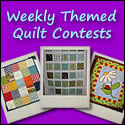Challenge pack with a fat quarter
and rules, shown on back of quilt.
I participated in a quilt challenge
a year ago, and while I was picking up my quilt, I picked up this year’s
challenge packet. Since the shop is 2 hours from my home, I planned my quilt
while still in the store, and bought an extra yard of the fabric to use for the
background. The theme this year is to use a traditional quilt block name
and make a new interpretation of the name. The quilt had to finish at 30
x 30, and use a recognizable amount of the challenge fabric. I had
planned to do a maple tree interpreting the traditional maple leaf block, and
to make the leaves from cast fiber. Since the finished size is 30 x 30, I
decided to make the background from 6 inch blocks. I added 2 blue solids
and flipped the color placement in each adjacent block.
Next, I enlarged and printed out a
drawing of a red maple tree to the size needed for the piece, laid it on the
back, and traced it onto the paper side of Wonder Under. After fusing to
brown fabric, it was carefully cut with embroidery scissors. I drew some
concentric circles starting in the center of the paper, and cut out the center
areas first, working outward to keep from handling the already-cut areas.
What’s left of my challenge fabric.
Two Maple Leaf blocks
Cut out tree was carefully slid onto
the quilt top, after peeling off the backing paper, then fused in place.
Quilting started on the branches,
shown from the back.
Tree is quilted, and background will
be as well (backside of quilt). Lots of small spaces to quilt, and a ton
of thread ends to pull to the inside.
Cast fiber leaves, made by taking
real leaves, covering with 2-3 layers of silk and bamboo roving, then wetted
with soapy water, blotted, and brushed with textile medium. When dry, the
leaf shapes are cut out & leaves peeled off. Casting leaves the
imprint of the veins.
More cast fiber leaves. You
can see the imprint of the veins. Sometimes the leaves crumble and small pieces
remain, as they did here.
Sheet of cast fiber. Leaves
wind up on the bottom until it’s dry, then shapes are cut out and leaves are
peeled off.
Not enough leaves. I went to a
friend’s house and gathered tiny new leaves from her Swamp red Maples.
Filled a phone book, then cast them all a couple days later.
Still looking sparse in the leaf
department. I made a sheet of cast fiber and cut leaf outlines, 4 at a
time, to use behind other leaves.
Maybe enough leaves now. Each
is hand sewn down the center vein, leaving the edges free. A few lines
were embroidered to suggest ground, and the last few leaves were attached.
Detail of finished piece
Swamp Maple
At the quilt exhibit.































































